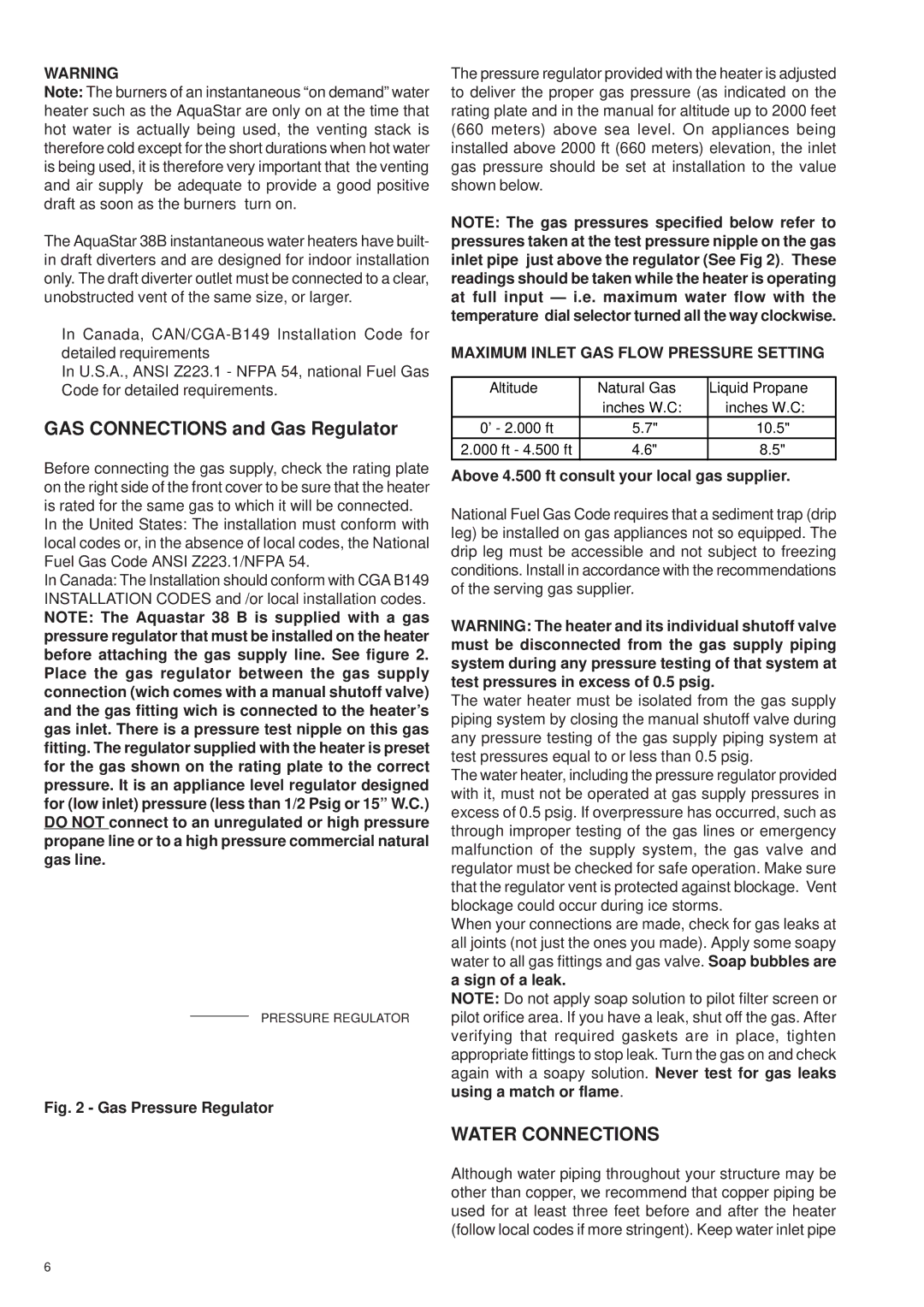WARNING
Note: The burners of an instantaneous “on demand” water heater such as the AquaStar are only on at the time that hot water is actually being used, the venting stack is therefore cold except for the short durations when hot water is being used, it is therefore very important that the venting and air supply be adequate to provide a good positive draft as soon as the burners turn on.
The AquaStar 38B instantaneous water heaters have built- in draft diverters and are designed for indoor installation only. The draft diverter outlet must be connected to a clear, unobstructed vent of the same size, or larger.
In Canada, CAN/CGA-B149 Installation Code for detailed requirements
In U.S.A., ANSI Z223.1 - NFPA 54, national Fuel Gas Code for detailed requirements.
GAS CONNECTIONS and Gas Regulator
Before connecting the gas supply, check the rating plate on the right side of the front cover to be sure that the heater is rated for the same gas to which it will be connected.
In the United States: The installation must conform with local codes or, in the absence of local codes, the National Fuel Gas Code ANSI Z223.1/NFPA 54.
In Canada: The Installation should conform with CGA B149 INSTALLATION CODES and /or local installation codes.
NOTE: The Aquastar 38 B is supplied with a gas pressure regulator that must be installed on the heater before attaching the gas supply line. See figure 2. Place the gas regulator between the gas supply connection (wich comes with a manual shutoff valve) and the gas fitting wich is connected to the heater’s gas inlet. There is a pressure test nipple on this gas fitting. The regulator supplied with the heater is preset for the gas shown on the rating plate to the correct pressure. It is an appliance level regulator designed for (low inlet) pressure (less than 1/2 Psig or 15” W.C.) DO NOT connect to an unregulated or high pressure propane line or to a high pressure commercial natural gas line.
PRESSURE REGULATOR
Fig. 2 - Gas Pressure Regulator
The pressure regulator provided with the heater is adjusted to deliver the proper gas pressure (as indicated on the rating plate and in the manual for altitude up to 2000 feet (660 meters) above sea level. On appliances being installed above 2000 ft (660 meters) elevation, the inlet gas pressure should be set at installation to the value shown below.
NOTE: The gas pressures specified below refer to pressures taken at the test pressure nipple on the gas inlet pipe just above the regulator (See Fig 2). These readings should be taken while the heater is operating at full input — i.e. maximum water flow with the temperature dial selector turned all the way clockwise.
MAXIMUM INLET GAS FLOW PRESSURE SETTING
Altitude | Natural Gas | Liquid Propane |
| inches W.C: | inches W.C: |
0' - 2.000 ft | 5.7" | 10.5" |
2.000 ft - 4.500 ft | 4.6" | 8.5" |
Above 4.500 ft consult your local gas supplier.
National Fuel Gas Code requires that a sediment trap (drip leg) be installed on gas appliances not so equipped. The drip leg must be accessible and not subject to freezing conditions. Install in accordance with the recommendations of the serving gas supplier.
WARNING: The heater and its individual shutoff valve must be disconnected from the gas supply piping system during any pressure testing of that system at test pressures in excess of 0.5 psig.
The water heater must be isolated from the gas supply piping system by closing the manual shutoff valve during any pressure testing of the gas supply piping system at test pressures equal to or less than 0.5 psig.
The water heater, including the pressure regulator provided with it, must not be operated at gas supply pressures in excess of 0.5 psig. If overpressure has occurred, such as through improper testing of the gas lines or emergency malfunction of the supply system, the gas valve and regulator must be checked for safe operation. Make sure that the regulator vent is protected against blockage. Vent blockage could occur during ice storms.
When your connections are made, check for gas leaks at all joints (not just the ones you made). Apply some soapy water to all gas fittings and gas valve. Soap bubbles are a sign of a leak.
NOTE: Do not apply soap solution to pilot filter screen or pilot orifice area. If you have a leak, shut off the gas. After verifying that required gaskets are in place, tighten appropriate fittings to stop leak. Turn the gas on and check again with a soapy solution. Never test for gas leaks using a match or flame.
WATER CONNECTIONS
Although water piping throughout your structure may be other than copper, we recommend that copper piping be used for at least three feet before and after the heater (follow local codes if more stringent). Keep water inlet pipe

